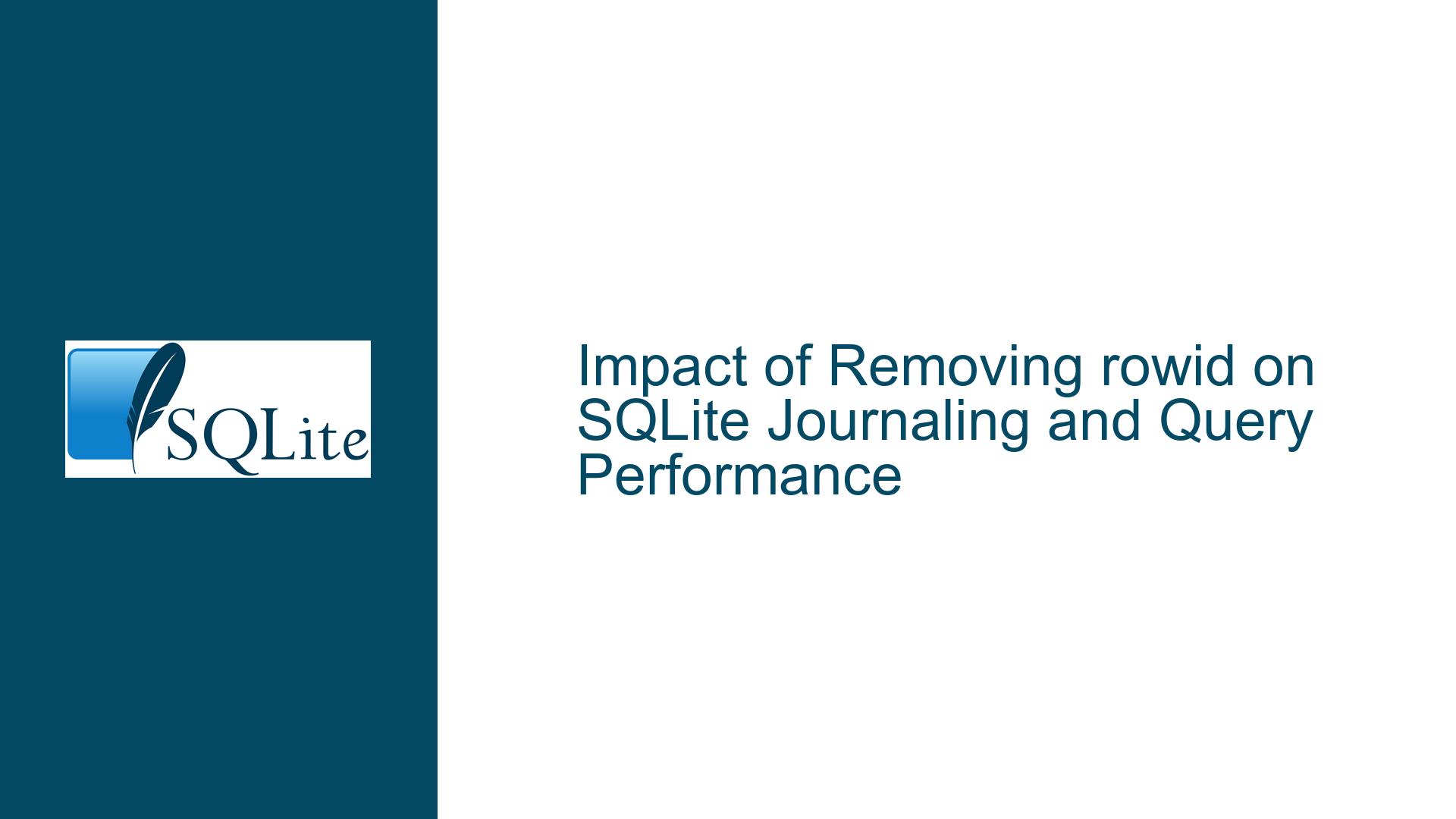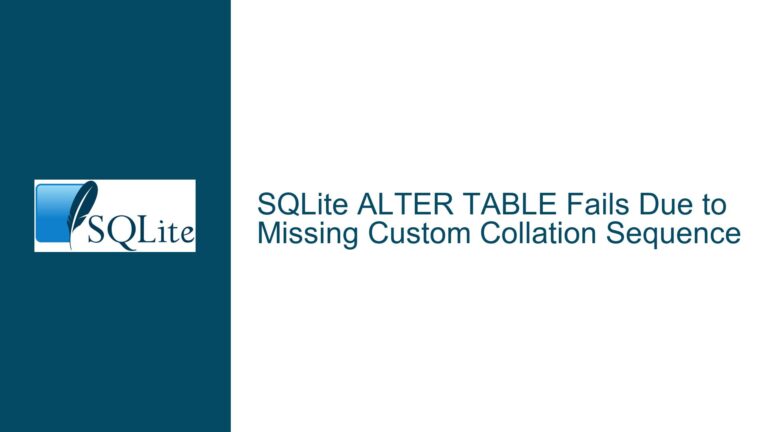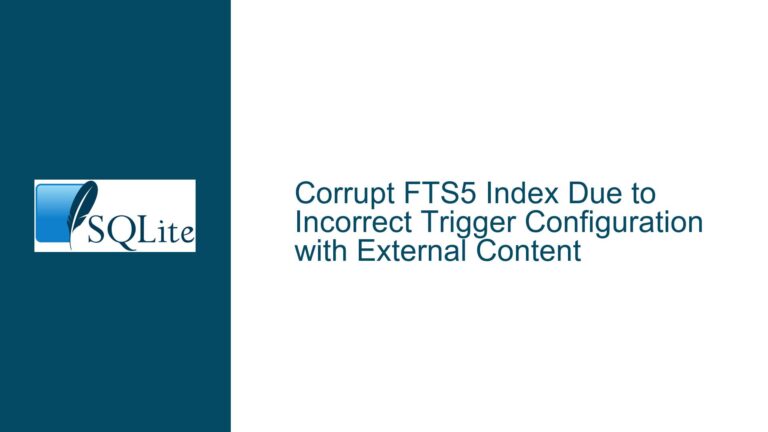Impact of Removing rowid on SQLite Journaling and Query Performance
Understanding rowid Removal in WITHOUT ROWID Tables and Journaling Interactions
The rowid is an implicit, auto-incrementing integer column that serves as the primary key for standard SQLite tables. When a table is declared as WITHOUT ROWID, this implicit column is eliminated, and the table instead uses a user-defined composite primary key to organize its storage structure. This optimization is recommended for tables with composite primary keys to reduce storage overhead and improve performance. However, developers often question whether removing the rowid impacts SQLite’s journaling mechanism (critical for ACID compliance) or introduces unintended performance trade-offs.
SQLite’s journaling ensures atomic commits and rollbacks by logging changes to the database during transactions. The journaling process operates at the page level (typically 4KB blocks) rather than tracking individual rows or rowid values. This means journaling does not inherently depend on the presence of a rowid column. Instead, it records modifications to database pages, regardless of the underlying table structure.
Regarding query performance, WITHOUT ROWID tables can offer significant speed improvements for specific operations. By clustering data directly on the composite primary key’s B-tree structure, SQLite eliminates the need for a separate rowid index. This reduces disk I/O and accelerates lookups, inserts, updates, and deletes that leverage the primary key. However, the impact on non-key queries or operations requiring secondary indexes must be evaluated on a case-by-case basis.
Factors Influencing Journaling Mechanisms and Performance in rowid-Free Tables
1. Journaling Dependency on Page-Level Modifications
SQLite’s journaling modes (DELETE, TRUNCATE, PERSIST, MEMORY, WAL) function by tracking changes to entire database pages, not individual rows or rowid values. When a transaction modifies a page (e.g., inserting a row into a WITHOUT ROWID table), the original page content is copied to the journal file. This process is agnostic to whether the table has a rowid or uses a composite key. The absence of rowid does not alter how pages are logged, restored, or rolled back.
2. Composite Key Storage and Indexing Overhead
In standard tables, the rowid serves as the primary key and is automatically indexed. Queries filtering by rowid benefit from direct B-tree lookups. In WITHOUT ROWID tables, the composite primary key replaces the rowid, merging the data storage and primary key index into a single structure. This eliminates the rowid index and reduces storage overhead, but it also means that queries not leveraging the composite key may require secondary indexes to maintain performance.
3. Query Plan Optimization and Access Patterns
The performance impact of removing rowid depends heavily on query patterns:
- Positive Impact: Queries filtering or joining on the composite primary key will execute faster due to the clustered B-tree structure.
- Neutral/Negative Impact: Queries relying on secondary indexes or full-table scans may see no improvement or slight degradation if the composite key’s size increases storage requirements.
4. Write Amplification in WAL Mode
In Write-Ahead Logging (WAL) mode, changes are appended to a WAL file instead of overwriting the main database. While WITHOUT ROWID tables reduce index maintenance, large composite keys may increase the size of WAL entries, indirectly affecting write throughput.
Validating Journaling Behavior and Optimizing Query Efficiency in rowid-Optimized Schemas
Step 1: Verify Journaling Consistency Across Table Types
Objective: Confirm that journaling operates identically for standard and WITHOUT ROWID tables.
Procedure:
- Create two tables with identical schemas—one standard and one WITHOUT ROWID:
CREATE TABLE standard_table (a INT, b INT, PRIMARY KEY(a, b)); CREATE TABLE without_rowid_table (a INT, b INT, PRIMARY KEY(a, b)) WITHOUT ROWID; - Enable PRAGMA journal_mode = WAL; (or other modes).
- Perform transactions (INSERT/UPDATE/DELETE) on both tables.
- Force a crash simulation using PRAGMA crash_on_write =
; (requires custom build) or abrupt termination. - Restart the database and verify data integrity using PRAGMA integrity_check;.
Outcome: Both tables should recover identically, confirming that journaling does not rely on rowid.
Step 2: Benchmark Query Performance with Real-World Workloads
Objective: Measure the impact of rowid removal on query execution times.
Procedure:
- Populate both tables with identical datasets (e.g., 1 million rows).
- Execute key-based queries:
SELECT * FROM standard_table WHERE a = ? AND b = ?; SELECT * FROM without_rowid_table WHERE a = ? AND b = ?; - Execute non-key queries requiring secondary indexes:
CREATE INDEX idx_standard ON standard_table(a); CREATE INDEX idx_without_rowid ON without_rowid_table(a); SELECT * FROM standard_table WHERE a = ?; SELECT * FROM without_rowid_table WHERE a = ?; - Compare execution times using sqlite3_exec() with timing enabled or EXPLAIN QUERY PLAN.
Outcome: Key-based queries on WITHOUT ROWID tables will typically execute faster (up to 2x), while non-key queries may show negligible differences.
Step 3: Optimize Schema Design for rowid-Free Tables
Best Practices:
- Use WITHOUT ROWID only for tables with composite primary keys that are frequently queried.
- Avoid excessively large composite keys, as they increase storage and memory usage.
- Ensure secondary indexes cover columns used in WHERE clauses or JOIN conditions.
Anti-Patterns:
- Using WITHOUT ROWID for tables with single-column primary keys (minimal gains).
- Over-indexing, which negates storage savings.
Step 4: Monitor WAL File Behavior
Objective: Detect write amplification in WAL mode.
Procedure:
- Monitor WAL file size during bulk inserts:
PRAGMA wal_checkpoint; SELECT * FROM pragma_wal_stats; - Compare WAL growth rates between standard and WITHOUT ROWID tables.
Outcome: Larger composite keys may increase WAL size, but this is often offset by reduced index maintenance.
By systematically validating journaling behavior, benchmarking query patterns, and adhering to schema design best practices, developers can confidently leverage WITHOUT ROWID tables to achieve performance gains without compromising data integrity.






